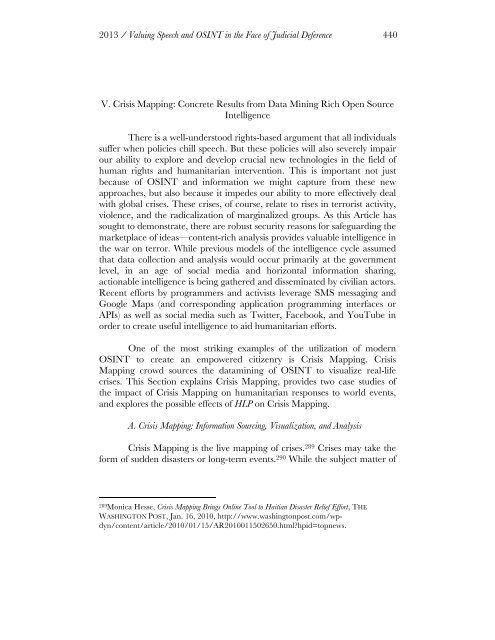Vo.4-Moshirnia-Final
Vo.4-Moshirnia-Final
Vo.4-Moshirnia-Final
You also want an ePaper? Increase the reach of your titles
YUMPU automatically turns print PDFs into web optimized ePapers that Google loves.
2013 / Valuing Speech and OSINT in the Face of Judicial Deference 440<br />
V. Crisis Mapping: Concrete Results from Data Mining Rich Open Source<br />
Intelligence<br />
There is a well-understood rights-based argument that all individuals<br />
suffer when policies chill speech. But these policies will also severely impair<br />
our ability to explore and develop crucial new technologies in the field of<br />
human rights and humanitarian intervention. This is important not just<br />
because of OSINT and information we might capture from these new<br />
approaches, but also because it impedes our ability to more effectively deal<br />
with global crises. These crises, of course, relate to rises in terrorist activity,<br />
violence, and the radicalization of marginalized groups. As this Article has<br />
sought to demonstrate, there are robust security reasons for safeguarding the<br />
marketplace of ideas—content-rich analysis provides valuable intelligence in<br />
the war on terror. While previous models of the intelligence cycle assumed<br />
that data collection and analysis would occur primarily at the government<br />
level, in an age of social media and horizontal information sharing,<br />
actionable intelligence is being gathered and disseminated by civilian actors.<br />
Recent efforts by programmers and activists leverage SMS messaging and<br />
Google Maps (and corresponding application programming interfaces or<br />
APIs) as well as social media such as Twitter, Facebook, and YouTube in<br />
order to create useful intelligence to aid humanitarian efforts.<br />
One of the most striking examples of the utilization of modern<br />
OSINT to create an empowered citizenry is Crisis Mapping. Crisis<br />
Mapping crowd sources the datamining of OSINT to visualize real-life<br />
crises. This Section explains Crisis Mapping, provides two case studies of<br />
the impact of Crisis Mapping on humanitarian responses to world events,<br />
and explores the possible effects of HLP on Crisis Mapping.<br />
A. Crisis Mapping: Information Sourcing, Visualization, and Analysis<br />
Crisis Mapping is the live mapping of crises. 289 Crises may take the<br />
form of sudden disasters or long-term events. 290 While the subject matter of<br />
289Monica Hesse, Crisis Mapping Brings Online Tool to Haitian Disaster Relief Effort, THE<br />
WASHINGTON POST, Jan. 16, 2010, http://www.washingtonpost.com/wpdyn/content/article/2010/01/15/AR2010011502650.html?hpid=topnews.
















